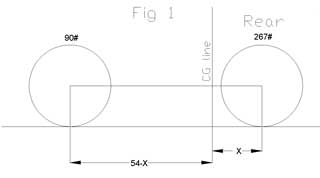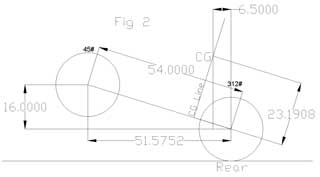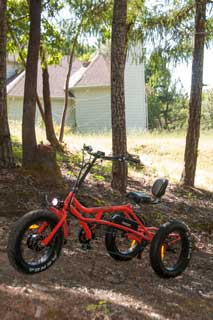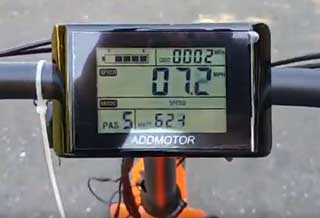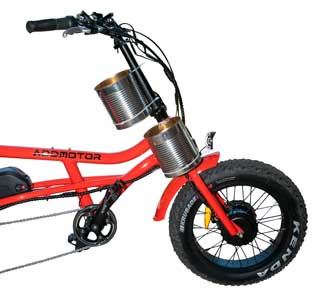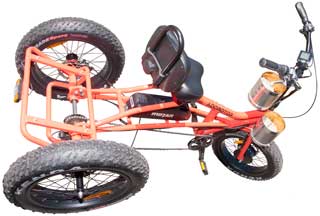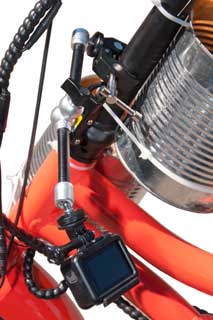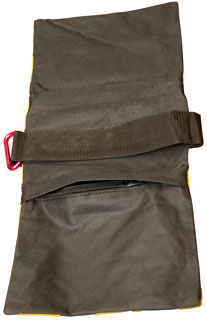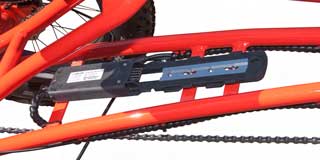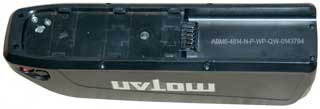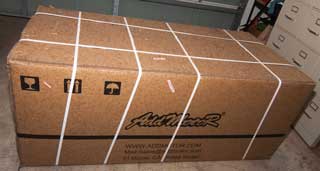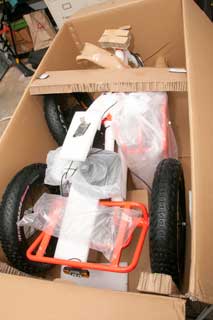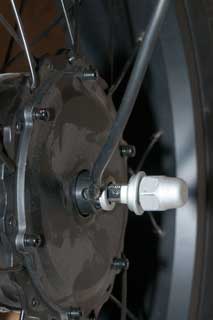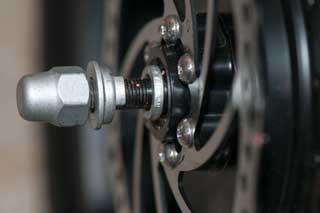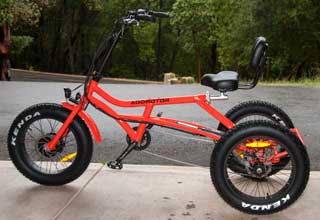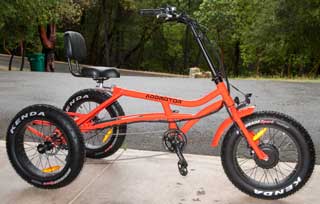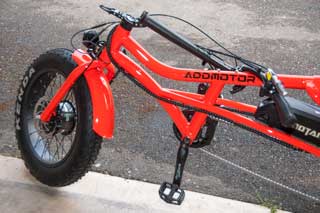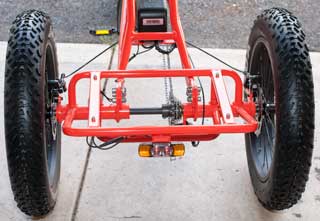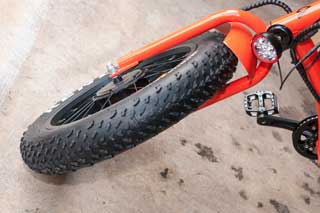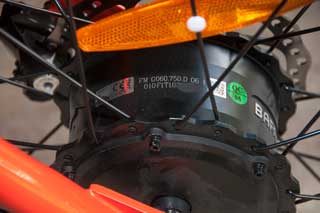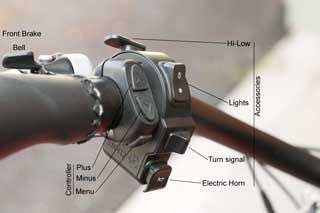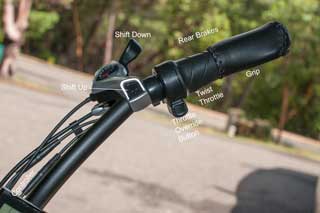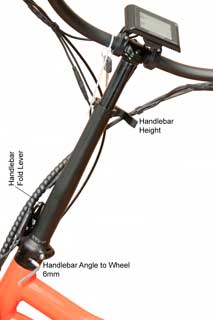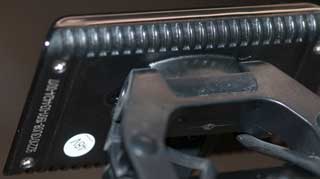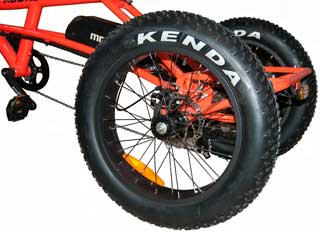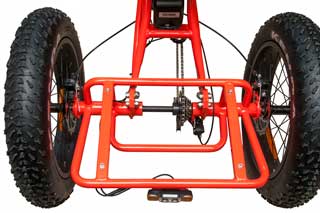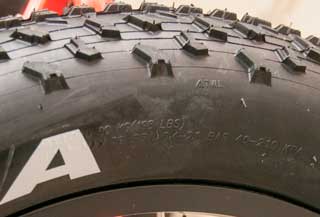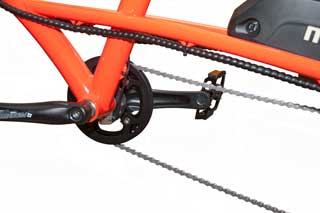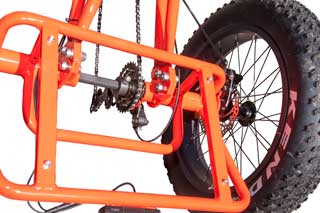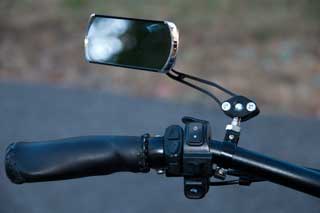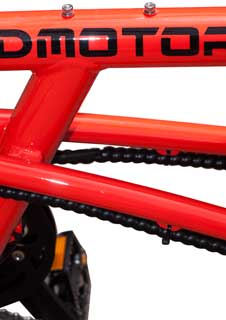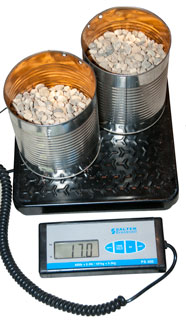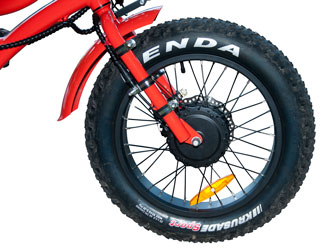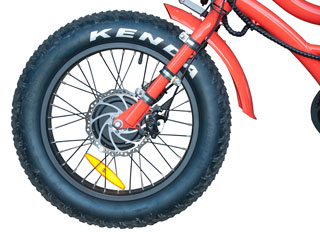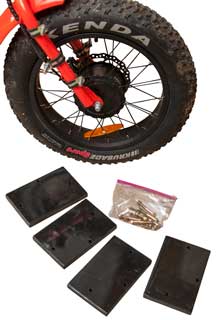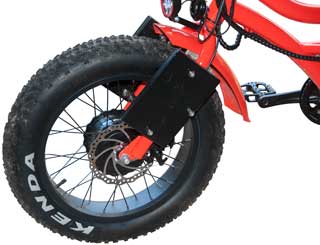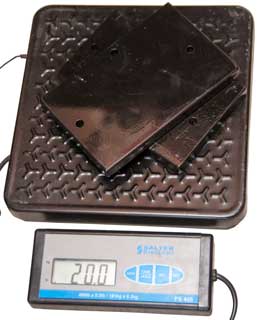Addmotor MOTAN M-360 Electric Fat Trike
© Brooke Clarke 2019 (testing Google auto ads)
Fig 35 Locating
center of gravity |
Fig 40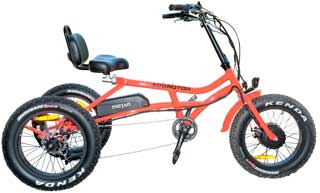 |
Fig 48 Basket has large holes.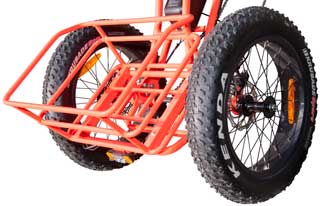 |
Fig 46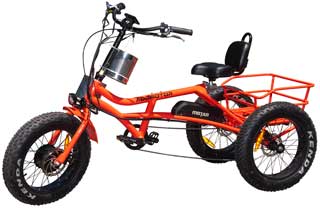 |
Fig 41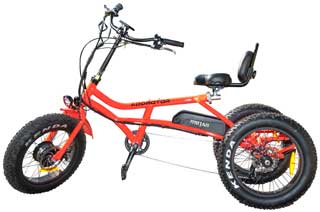 |
Order & Shipping
Test Drive
Problems
Description
Handlebar
Seat
Water Bottle Mount
Drive Train
Front Geared Bafang Hub Motor
Tires
Tire Size
Right Rear Wheel Pedal Power
Weight and Center of Mass
Hill Climbing
Battery & Motor Controller
Front Forks
Photos
Assembly
Overall
Patents
Trailer
Related Trikes
Related
References
Links
Background
For a number of years I've been studying electric and gas powered bicycles (see my Related web pages below). When I started looking all the hub motors were direct drive, i.e. the torque the motor generated was the torque on the wheel. This means as the wheel diameter gets larger the force pushing the bike forward goes down. In a practical way these would not work in the mountains where I live.
The Recumbent Tadpole design (Wiki) offers a low center of gravity and so is good for stability for high speed off road conditions, but suffers from being hard to see by car or truck drivers, so not so good for on road use.
The higher seating position of the Delta Trike (Wiki), like the M-360, is safer when near cars because you have about equal height eye lines.
But at some time in the recent past hub motors improved with the addition of internal gearing and they may work here in the mountains.
The reason for getting a trike is that I want to use this like a small tractor or Garden Tractor not for ground engagement since I doubt that would work, but to move things around like Waste Management garbage, recycling and yard waste containers up and down a driveway with a 10.1 degree grade as well as move felled logs out of my forest to the side of the road where people will pick them up to use as firewood. A small dumping trailer would also be handy. This may require a motor upgrade where all wheels would have hub motors and/or adding a mid drive motor. To Be Determined.
Mountains
With the exception of a small area immediately adjacent to my house all the land, paths and roads here are either steep up hill or steep down hill. This means I never shift out of low gear (which is too high). When going up hill I need a pedal gear much lower than the lowest gear that came with the trike.
When going down hill no motor or pedaling is needed, just good brakes.
Order & Shipping
The AddMotoR Motan M-360 was ordered on 9 May 2016 about 7 days prior to the close of the 30% off sale.
Shipped via Oak Harbor Freight Lines from Los Angles on Monday 13 May to Sacramento. Scheduled to be delivered here in Northern California on Wednesday 15 May. It was.
I was watching as soon as the M-360 was announced and did not understand how the AddMotoR Crowdfunding sale works. It started out at $1599 (40% off).
There are two ways the price gets increased. The bar graph shows the number of units sold. When the next number to the right is sold the price notches up.
So, after 10 trikes were sold the price notched up from $1599 to $1899 even though there was a few weeks shown on the count down time.
So today the units sold was at 10 and after my order just above 10.
Original Price:USD $2,699.00
Price: USD $1,899 (29% off) (only 7 days)
The presale discount ends in a couple of days from Tuesday 14 May, i.e. Thursday 16 May, 2019 when the retail price reverts to $2,699.
16 May 2019 - M-360 price now $2,999.00.
Their tracking info shown below.
Ordered Thursday 9 May. Shipped the next Monday 13 May.
Date Time Action Location 05/15/19 17:26 Delivered Signature-BROOKE C. Ukiah, CA 05/15/19 10:46 Dispatched for delivery Eureka, CA , (707) 441-1474 05/15/19 08:44 Arrived at terminal Eureka, CA , (707) 441-1474 05/15/19 08:16 Dispatch from FOR Fortuna, CA 05/15/19 07:50 Arrived at terminal Fortuna, CA 05/15/19 01:47 Leaving Terminal Sacramento, CA , (916) 371-2564 05/14/19 05:52 Arrived at terminal Sacramento, CA , (916) 371-2564 05/13/19 22:30 Leaving Terminal Los Angeles, CA , (323) 869-5960 05/13/19 16:08 Picked Up Los Angeles, CA , (323) 869-5960
Test Drive
No. 1 17 May 2019
1. Path around my house. This is a gravel/dirt walking path but the M-360 could not make the uphill climb. The front wheel spins.
PS even in Pedal Assist Setting 1 the speed it too fast for riding on the path around my house. There is a pedal movement sensor, not a pedal torque sensor which would be much better. As it is now once the pedal has moved over some angle the motor starts up much too fast and the brakes are needed, but that turns off the motor.
2. Street in front of my house. While climbing on asphalt road the front wheel is spinning. Pedaling in first or second gear helps, but is not enough.
Looks like either a mid drive motor with added differential or dual rear wheel hub motors may be needed to get power to both rear wheels. Maybe adding weight to front wheel?
When going down hill it's all braking, no power needed.
Motor Control
There is a disk connected to the crank with a number of magnets and the movement of that disk can act as a cadence (Wiki) sensor. This is used as the input for the Pedal Assist System (PAS).
The motor is powered on when the PAS sees a couple of magnets go past the sensor. The problem with this is that the motor comes on much stronger than desired. To the point that you soon learn to put on the brakes to slow down. But that turns off the motor since there is a brake sensor. It is impossible to pedal and have the motor in a slow speed mode.
A much better system uses a crank torque sensor so that the motor power is proportional to the crank torque. But that's more expensive than the cadence sensor.
It seems the first PAS level selected after power-on is locked in. If I start out in PAS 1 and while moving change to PAS 5 then opening the throttle has no effect. I need to press the throttle override button to get the throttle to do anything.
Problems
All front wheel drive electric bikes will be very limited in climbing hills because of weight transfer!
Major
- The center of gravity is too far to the rear to the point that it's impossible on the stock trike to climb a grade of about 10 degrees or steeper. See: Weight & c.g.
- The basket has holes so large that it's not practical to carry mail. It needs a liner/basket. See Fig 48 Note it's really not the holes, but the need for a closable container that will prevent the wind from blowing away mail.
- The seat post clamp is not strong enough to keep the seat from turning left or right. See: Seat
- The pinch screw that locks the alignment setting for the front wheel relative to the handlebars is not strong enough. See: Handlebar: Folding & Adjusting
- There is no parking brake. This is a real problem if you are on sloping ground and need to take you hands off the trike.
Minor
- The manual could have a better description of how to assemble the front wheel see Fig 7.
- The manual should include the button press to turn on the LCD back light, but better would be for the firmware to do that whenever the headlight is on. See Fig 27.
- The manual has no information about using the State of Charge indicator on the battery. See Battery & Motor Controller.
- The Pedal Assist is too aggressive. In PAS 1 when it kicks in it's way too fast. A torque sensor would be much better, but that may no be practical for the selling price.
- Lack of parking brake function. For example I used tie-Wraps when measuring the c.g. See: Fig 35 Whenever parking the M-360 care is needed to keep it from rolling downhill.
- It's not clear if a water bottle holder (color matched to the Trike) was supposed to be shipped with the Trike or if it is an option or . . . . ? See Fig 49.
- There is a button next to the throttle that MUST be pressed to allow the throttle to work. The manual is not at all clear about it's function.
Description
A tricycle with one steering wheel in front and two rear wheels (Wiki: Delta Trike). Only the right rear wheel is powered by pedaling. The front wheel has a hub motor rated 750 Watts powered from a 48V battery rated at 14.5 Amp hour capacity (48V * 14.5 Ah = 696 Watt hours; 696 Wh / 750W = 55 minutes running at full power, much longer at lower power levels). See Front Geared Hub Motor.
Even considering the Problems, this is good value for the money. There is a far superior trike on the market from ElectricTrike.com, but it's priced at $3,500, not in the same category as this trike.
24 June 2019 - Electric Bike Technologies 23 June 2019 - @ 4:04 new trike, Bafang Ultra mid motor, limited slip differential rear end - this looks very promising. . . TBD
26 June 2019 - Electric Mid-Drive Fat Trike - mid drive motor with torque sensing, limited slip differential, hydraulic brakes on 3 wheels, YouTube: EBR:Electric Bike Technologies Electric Fat Trike Mid-Drive Review - $3.5k 26:33 - Written review - in the video he says it went up a (small) hill, a good thing.0.
Design
This is a beach cruiser tricycle. It's related to a crank forward bicycle (electric bike, Rans) in that you can put your feet on the ground and the seating position is comfortable. Also has the possibility of "digging in", i.e. pulling up on the handlebars while pushing on a pedal.
Handlebar
22mm diameter.
I have a smart phone mount and rear view mirror on order.
Left
See Fig 26. Front brake lever, bell; Controller: Menu, Minus, Plus, Accessories: Electric Horn, Turn Signal, Lights On/Off, Hi/Low Beam
Center
Controller (see Fig 27) and Fig 29).
The input buttons [Menu (Mode), Minus (Down), Plus (Up)] are on the left side of the handlebar, see Fig 26.
Right
See Fig 25.
Folding & Adjusting
By pressing a button and pulling a lever the handlebar and the stalk above the top of the frame can be folded down to reduce the overall height of the trike, see Fig 22.
Note that the hinge is offset maybe 30 degrees from front-rear alignment so that when folded down the handle bar is as low as possible.
See Fig 30. There is a lever which when opened allows changing the ride height of the handlebar.
A 6mm hex pinch bolt allows rotating the handlebar left-right so that it can be adjusted square to the front wheel. This is not strong enough to lock the handlebars to the front wheel. That's to say you can adjust the handlebar to front wheel angle with the pinch bolt as tight as you can get it simply by placing the front wheel next to a wall and turning the handlebar in the direction to cause the front wheel to turn into the wall.
Seat
The seat has an adjustable backrest and is comfortable. The problem is the pinch screw that holds the seat onto the vertical support post (Fig 6) is not strong enough to keep the seat from turning left to right during normal pedaling or getting on and off. See Fig 35, Fig 36, Fig 43,
Water Bottle Mount
Just in front of the seat on the top of the top frame tube is what appears to be two mounting screws for a water bottle, or accessory that uses a water bottle mount.
The center-to-center distance is about 2-1/2" (63.75mm). The hex bolts have 5-0.8mm threads and use a 4mm hex wrench.
Drive Train
Front Geared Bafang Hub Motor
As of 9 May 2019 I have not been able to get details on the exact Bafang motor that's used or its technical specifications. Only that it is a front geared hub motor rated for 750 Watts.
Fig 28 shows the motor marked Bafang FM G060.750.D.
The part number translates as: Front Motor, Geared, series 060, 750 Watts, Disk brake
The closest Bafang model on line today (5.17.2019) is the RM G060.750.DC -
Other braking options are R: Roller (a form of drum brake built into motor see: Shimano Roller Brake), V: V Brake (side pull rim brakes), DC: Disk brake & Cassette.
The FM G060.750.D might be the same as the RM G060.750.DC with the only change being elimination of the provision for a cassette?
Comments on the below Specifications from the factory web page RM G060.750.DC:
Front instead of Rear mount.
20" wheels, not larger sizes - increases force for given torque (shorter lever arm).
n0 (PRM)
nT (RPM)
SPECIFICATIONS
Core Data
Position Rear Motor Wheel Diameter (Inch) 26/27.5/28 Construction Gear drive Rated Voltage (DCV) 36/43/48 n0 (Rpm) 325 ; 245 Rated Power (W) 750 (1 Horsepower)
nT(Rpm) 290 ; 205 Max Torque 80 N.m (59 Ft-lbs)
Efficiency (%) ≥ 80 Color Black / Silver Weight (kg) 4.6 Noise Grade (dB) <55 Operating Temperature -20 - 45℃ Mounting Parameters
Brake Disc Brake Installation Widths (mm / OLD) 175 Max. Housing Diameter (mm) 158.5 Cabling Route Through Shaft, Right Cable Length(mm), Connection Type 250 G9.1 Gearshift Cassette Spoke Specification 36H*12G Further Specifications
Speed Detection Signal (Pulses/Cycle) 6 Reduction Ratio 1:5 Magnet Poles (2P) 20 Tests & Certifications
IP IP 65 Certifications ROHS / CE Salt Spray Test Standard(h) 96 DIMENSIONS

Dimension A 97mm Dimension B 68mm Dimension C Φ 158.5mm Dimension D Φ 145mm Dimension E Φ 44mm Dimension F Φ 33mm Dimension G 2–M12 x 1.25–6g Dimension H 2.7mm Dimension I 26.5mm Dimension J 43.5mm Dimension K 15.25 Dimension WL 84.6 Dimension WR 90.4mm Dimension OLD 175mm Tires
These are air inflated balloon tires (see: Cars: Tires, Bicycle Tires)
Search term: "Kenda Krusade 20 x 4.0 Tire 60 TPI Black" has hits on Walmart, Amazon, eBay, but not any Kenda tire web page.
Inflation pressure 5 to 30 PSI. Max load 198 pounds. Implies a GVW of 594 pounds for 3 wheels.
The word "moped" as well as "98-406 20x4.0 60 TPI casing, Wire bead, 5-30 PSI", "90/100-16 24B" appear on the sidewall.
The tire pressure is the same as the ground pressure (Wiki). On soft ground if the ground pressure is too high the wheel will dig into the ground making it difficult or impossible to go forward. Lowering the tire pressure under these conditions allows the vehicle to stay on top of the ground and proceed. The HMMWV has an on board air compressor and rotating joints on each wheel with instrument panel control of the tire pressure for just this reason. Some ATVs (Wiki) are required to have tire pressures in the 4 or 5 PSI range to prevent damaging the ground.
Another effect of lowering the tire pressure is to reduce the rolling radius of the wheel. Since torque = force * rolling radius for a wheel, for a given torque you get more force with a shorter rolling radius. But if the wheel is spinning when inflated near the maximum pressure adding more force by lowering the tire pressure (rolling radius) does not help with hill climbing.
For drag racing (Wiki) the very fastest cars under inflate the drive tires for two reasons. First to increase the area of the contact patch so that when the wheel spins more rubber is sheared off creating more force. Second as speed is picked up along the track the wheel expands acting as a transmission shifting into a higher gear. But neither of these effects applies to this trike.
So lowering tire pressure will NOT offer any improvement in hill climbing ability.
Higher tire pressure reduces rolling resistance (Wiki) on hard surfaces. Can be tested using "coast down" which also measures wind resistance.
Master's Thesis: The vehicle coast-down test.pdf - combines rolling resistance with aerodynamic parameters as well as ambient corrections. A lot of error analysis.
YouTube:How Mountain Bike Tires Are Made -
Tire Size The first number 4" in this case refers to the widest width of the tire. The second number 20" is the wheel diameter. But I measure about 16.5" as the wheel diameter, so what's up?
The rolling radius is 11.5" or a nominal outside diameter of 23".
Note that most adult trikes have a max width of 32" (the M-360 is 32") in order to go through doors in houses. Stability in turns depends on the location of the center of mass in relationship to the contact patches of all the tires. Since the rear track on these trikes is set by the 32" overall width the tire diameter becomes important in that the smaller it is the lower the center of mass is to the ground and the more stable. I suspect this is the reason tire diameter on similar trikes has been going down for the past few years.
Another benefit, and the one I paid attention to, is that the smaller the tire diameter the more traction force a given hub motor will deliver. My analysis of bikes and trikes some years ago was that they did not have enough torque to start climbing when pointing up hill. But the M-360 has plenty of torque, the problem is the location of the center of mass too far to the back.
Right Rear Wheel Pedal Power
The pedals, chain drive and rear Derailleur gear change (Wiki) are directed at only the right rear wheel, not the left rear wheel. It would add considerable cost and complexity to include a differential on the rear axle allowing both rear wheels to drive. See Fig 23 below.
After adding the two cans of rocks and attempting to ride on the path around my house I noticed the the right rear wheel was spinning due to my pedaling in low gear. So the M-360 would benefit from a rear differential or a way to lock the two half rear axles together when traction was important.
Weight and Center of Mass
Analyzing center of mass because the front tire spinning when trying to climb grades that can easily be walked. This is not a lack of power problem. Looking at weight transfer on uphill grades.
Examples of front hub motor wheel spin:
YouTube my driveway: Addmotor M-360 Trike Climbing 10 Degree Driveway -
18:39 Sun 24″ Traditional Electric Tricycle Video Review - Stable, Simple, Useful -
18:12 Trivel E-Fat Azteca Video Review - $3.9k Electric Recumbent Fat Trike - EBR - comment: "They should never have put the power hub on the front with 90% of the weight on the back." the EBR review: "I found that the front wheel would actually spin when starting in higher levels of assist, even on grass, because most of the frame and passenger weight is positioned over the two rear wheels. This is a common phenomenon with e-trikes and something that happened A LOT with the non-fat tire E-Azteca. You can reduce slipping, and premature tire wear by extension, by starting off in the lower levels of assist or easing into the twist throttle. I found that the twist throttle actually starts off more smoothly than pedal assist, even if you turned it all the way to full power. Perhaps future iterations of this bike will dial back on the pedal assist to match the throttle performance and reduce slipping."
In the YouTube:3 WHEEL FAT TIRE ELECTRIC BIKE ADVENTURE!!! AddMotoR MOTAN M-350 Trike Overview @ 6:54 he is riding near a number of hills, but does NOT try to climb any of them (or he did and found it could not climb them so did not show it spinning the front wheel.) 8:26 "500 Watt front hub motor in the front, it's geared, it's got about 80 Newton meters of torque. It's pretty powerful, it's pretty peppy, one of the issues and potential issues of having this motor up here in front is you can get wheel slippage."
Data
Wheel base: 54"
Static Weights Table
Center of axle to ground: 11.5"
M-360 only
M-360 +me
Front 33.5
90
Left Rear 24 117
Right Rear
26
150
Rear total
50
267
O.A. Total
83.5
357
M-360 only has slight rear weight bias (F; 33.5, R: 50).
M-360+me has much more rear weight bias (F: 90, R: 267).
With Front axle 27.5" off floor, or raised 16"
ASIN(16" / 54") = 17 degrees, close to the grades around here.
M-360 only M-360 +me Front 29.5
45
Rear total
54
312
total
83.52
357
Diagram
Fig 1:
M-360+me
Torque about CG and wheelbase line is balanced: (54"-x) * 90 = x * 267, X=13.6".
Note the CG is somewhere on a vertical line 13.6" in front of the rear axle
based on the front and rear weights when level.
Fig 2:
Front lifted 16" (17.2 deg) locates CG
M-360+me center of mass is closer to rear wheel.
The projected wheelbase on the floor is 51.575" long.
Torque about CG is balanced along plumb line: (51.575" - x) * 45 = x * 312; x= 6.5"
23.19" above axle line, or 34.7" above ground.
Fig 35
Measuring weight on front wheel when it's tipped up.
Thick corrugated cardboard used to raise wheels not on scale since they are about the same thickness. Erased the cardboard between rear wheels by mistake.
Note tie wraps on both hand brakes. The M-360 does NOT have a parking brake.
Fig 36
Fig 36 on the path around my house. You can see, using the house as a vertical reference the slope is around 10 degrees. Hard to see in photo is trench made by front wheel spinning.
This path is easy to walk here, so poor performance by the M-360.
Fig 45 Still from Driveway video at 0:19
YouTube my driveway: Addmotor M-360 Trike Climbing 10 Degree Driveway -
PAS: 5 throughout video.
Not pedaling until 0:10 when wheel is spinning so much trike starts to move backward.
Pedaling necessary to get up driveway.
Display shows:
Odometer: 0002 Miles
Speed: 07.2 MPH (ground speed is near 0, so this is wheel spin speed)
PAS: 5
623 Watts.
Fig 42 Added traction weight.
The two cans have rocks to add weight.
Was 29.5 # on front wheel from factory.
Now 45# with two cans of rocks, i.e. an additional 15.5# near front.
This allows going to the mailbox and getting up the driveway with minor pedaling.
Note the seat is all the way forward and the handlebars are all the way down.
It would work much better if the weight was added as far forward and as close to the ground as possible.
Note the top can turns with the steering but the bottom can is fixed to the frame.
Fig 43 View showing rocks in cans
The two cans are not full to the brim. Seems like near optimum additional weight.
A better solution would be less weight placed more forward and lower. That's to say the same improvement in traction can be achieved with less weight allowing better hill climbing since the horsepower needed to maintain a fixed speed depends on the weight among other factors.
Magic Arm Fig 3 mounting GoPro Hero 5 Black camera
So far have not moved the file because it exceeds the 25MB limit for email. So need to pull the memory card from the GoPro. Turns out it's over a GB, so impossible to upload with narrow band internet (at&t DSL).
Photography Light Stand Saddlebag Sandbag
Zuma Z-SBCW (Sand Bag Counter Weight)
eBay: "Photo Studio Counter Weight Sand Bag for Boom Stand/Arm Background System Set"
20" x 9"overall
The two pockets have a double zipper and are about 9" x 9" by about 2" thick
The widest single metal plate that will fit is 7". But two plates 8" x 4" x1" may work?
Volume = 2* 9 * 9 * 2 =324 cubic inches.
Material
Density
#/Cu Ft
Density
#/cu in
Sand
80
0.0460
Gravel
75
0.0434
Steel or Iron
490
0.2835
Lead
708
0.4100
Weight of 8" x 8" steel or iron plate
Note there are two
The existing 15 # of rocks is not enough. I have had the front wheel slip when driving uphill on the road near my driveway. Next try a couple of 1" slabs of steel or iron.
Thickness
Pounds
per pocket
Pounds
Total
1/8"
2.26
4.5
1/4"
4.5
9
1/2"
9
18
3/4"
13.5
27
1"
18
36
1-1/4"
22.5
45
Try 4 slabs each 8" x 4" x 1". 9-1/4# each, 37# total.
Unfolded
With front wheel drive there is no problem of flipping over with acceleration as would be the case with rear wheel drive where a "wheelie" (Wiki) could easily happen.
But as the uphill grade gets steeper the front wheel traction decreases rapidly.
Pull of Front Wheel
When on a slope the pull of the front wheel needs to exceed the slope component of the total vehicle weight in order to not roll backward. That component is the sine of the slope times the total weight. There is a second order effect where the pull is the cosine of the slope times total weight but at 10 degrees is only a 2% reduction so trivial compared to the weight transfer.
Slope
deg
357# * SIN(slope)
Note 1
Wt on Front Wheel
= max pull
0
0#
90#
5
31#
Note 2
10
61#
Note 2 11
68#
Note 2 17
104#
45#
33
194#
0#
Note 1: this is the force on the front wheel (no pedaling) needed to keep the M-360 from rolling backward.
Note 2: In order to calculate the max pull column an equation is needed relating the slope to the front wheel weight.
After doing the above I found this explanation of the method I used when searching for an easy way to calculate the weight on the front wheel.
Note they raise the Rear instead of the front and that causes problems when trying to just plug in values.
Car & Driver: Explained: How To Measure a Vehicle’s Center-of-Gravity Height -
Using their variable names:
W: total weight = 357 pounds
Wf: weight on front = 312 pounds (17 deg) (weight on rear since raising front)
L: wheelbase = 54"
a: rear wheel to CG distance = 40" (front to cg since raising front)
b: front wheel to CG distance = 14" (rear to cg since raising front)
Rf = Rr = rolling radius = 11.5"
Theta: slope angle = 17 degrees
Hcg = Rf * (a/L) + Rr * (b/L) + [(Wf * L) - (W*a)] /[ W * TAN(Theta)]
Hcg = [(11.5" * 40")/54"] + [(11.5" * 14")/54"] + [(312# * 54") - (357# * 40")] /[(357# * TAN(17.2)]
Hcg = 8.52" + 2.98" + [16848#" - 14280#"] / (357 * 0.306)
Hcg = 8.52 +2.98 + 23.23 = 34.7"
------------------------------
M-360 Front Weight = 357 - [145* TAN(Theta) + 267)] : for right column in Pull of Front Wheel table above.
M-360 Front Weight = 90 - [145* TAN(Theta)]
Red means the front wheel is spinning because there is not enough weight on it.
Slope
deg
M-360 Front
(actual traction)
#
357 * SIN(slope)
(needed traction)
#
0
90
0
5
77.3
31
10
64.4
61
11
61.8
68
17.2
45.1
105.6
31.8
0
188
This is consistent with the front wheel spinning on my driveway, house path and on the street to the mail boxes.
At a slope of 31.8 degrees all the weight is on the rear wheels, i.e. the front wheel is in the air so no traction at all.
Wired Magazine: What's the Steepest Gradient for a Road Bike? - Considers 3 limits: Rider Horsepower, weight transfer & static friction on a slope. (% grade causes a lot of problems so they switched to using degrees.)
Blue Monkey Bicycles:
Front Hub Vs Rear Hub eBike Motor - "One thing I can tell you is; not to go mountain biking with a front hub motor unless you want to fall down repeatedly."
This "hunting" of the front powered wheel happens on 2-wheel bicycles for the same reason it happens on eTrikes, i.e. weight transfer allows the front wheel to spin.
Hill Climbing
Unlike speed on flat ground which is a fixed parameter for a given bike, the ability to climb hills depends on the location of the center of mass which in turn depends on the rider and also it depends on the total weight and speed. I just watched a video review of the Evelo Compass eTrike and with a 135# rider it could climb a steep hill, but that does not mean it would with me on it. So I'm thinking of how to specify hill climbing ability.
One Horsepower (Wiki) is defined as lifting 550 pounds, one foot in one second.
5 MPH (8 km/h) = 26400 feet per hour, or 7.333333 Ft per second at the wheel.
If going up a slope that is the speed along the hypotenuse of the slope triangle.
For a 10 degree slope the vertical component would be Speed * SIN(slope deg) = 7.33333 * SIN(10) = 1.27 ft/sec.
The M-360 with me riding is 357# (162 kg).
English Horsepower is (357#/550#) * 1.27 ft/sec = 0.826 HP (To get the same answer using the Motor Power Calculator the slope needs to be input as 17.63% (not 10 degrees!).
Note the the HP is directly proportional to speed and weight, double either and the HP is doubled.
The calculation can be reversed, i.e. given a 750 Watt motor and a 10 degree slope, how fast is possible?
This calculation is a much simpler version of the calculation I did for drag racing a 427 Cobra finding speed v. distance and time.
The Speed (Power) Calculator at Electric Bicycle Guide (for 357# (162 kg), 5 MPH (8 km/h, 17.63%)
Total weight: 162 kg (357#)
Ground speed: 8 km/h (5 MPH)
Grade: 17.63% (10 deg)
Frontal area: 0
Drag coefficient: 0
Altitude: 0
Wind speed: 0
Rolling resistance coefficient: 0
Motor efficiency: 100
Motor configuration efficiency: 100
Total efficiency: 100
Rider power: 0
Total power: 613 Watts
Total power: 0.822 HP
Battery & Motor Controller
Hailong (aka: HL or Rocket) pioneered the Shark (aka Down Tube) battery package. This is the 48V version. The battery mount includes the motor controller. Normally the battery mount just has a couple of wires as outputs. The normal battery and mount has four electrical battery interface contacts (two for + and two for -), but this one has five. Because of the motor controller, the switch or . . . Let me know why.
Rated at 48 V and 14.5 AH 696 Watt hours.
I recently saw a review of a low end eTrike where the battery capacity was reduced to 300 some odd Wh in order to be allowed as checked baggage on an airliner. This also requires a special safety certification of the battery which the manufacturer was doing. This also would allow air freight shipping of the eTrike. Without the special certification only ground transportation under hazmat conditions is possible. I'm guessing the M-360 shipped from China in a container, not shipped by air freight.
Note that the military BB-2590 battery that contains a pair of "12 Volt" batteries where each battery is a 4S3P (24 cells total) has developed to include an SMB (Wiki) digital serial interface that allows determination of exact battery condition as well a programming the battery controller chip. This interface was developed for laptop batteries.
The prior versions, (M-330 & M-350) had a Silver Fish type battery in a vertical position behind the seat post. The problems were: 1. you needed to remove the seat (M-330) or tilt up the seat (M-350) to get the battery out. 2. When installing the battery it was possible to drop it and damage the battery and/or it's mount.
Fig 37
Intelligent Brushless Motor Controller part of battery mount.
Lvbelan Model: QS-C48-18125 (2019 Feb 22)
48V, Off Voltage: 40V, Current: 25A
Power 1,000 Watts.
5 terminal battery connector
for use with LCD Display DWLCD-U
Fig 38 Bottom of battery.
Red On/Off switch and battery charger socket at left.
Stamped: ABM6-4814-N-P-WP-QW-nnnnnnn
The round metal lock pin at the left is moved by the key.
This locks the battery to the mount.
It has no electrical function.
Needs to always be locked when riding to keep the battery
from falling off. Only used when you want to remove
battery from bike, like to take inside.
It can be charged without removing from bike.
Fig 39 Hailong logo and "Down Tube" at top center.
State of Charge indicator at right with "test" button.
4 each LED glow green, yellow or red when center "test" button is pressed.
Front Forks
Still looking for a good way to add weight low and to the front. What's called a Low Rider Front Pannier Rack seems to be what's needed.
The standard size Tubus Mid-fork eyelets work on fork diameters of 20 - 32mm and the M-360 has 32mm dia front forks. The Tubus oversize model fits 33 to 40mm dia forks and would be too big.
Note 33mm = 1.26" or very close to 1-1/4".
An even simpler system is to use rubberized P-clamps that will fit a 1-1/4" dia. tube. These could be attached to a metal plate on each side.
eBay title: "Qty. 10 Adel Cushion P-Clamp Fits 1 1/4" Tube, Wire Loom, Hose MS21333-129 Loop (152923857571)" about $20.
The 1-1/4" P-clamps look like they will work. The bolt hole will clear a 3/8" bolt, so need to get some.
Photos
Assembly
Fig 1 Delivered by Oak Harbor Freight Lines
Lift gate truck, hand truck up hill and into garage.
Fig 2 Cut tape and pulled staples with pliers.
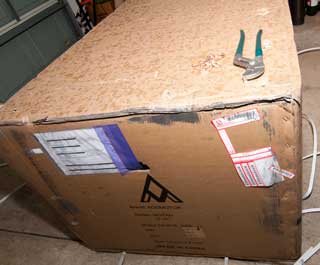
Fig 3 as received
Only the three small boxes were loose.
Everything else was trapped and could not move.
Nice, but could be a little better.
See Packing for Shipment
Fig 4 Removed front wheel, basket, seat, small boxes & spacers. Note short lid folds against box with a big gap to floor.
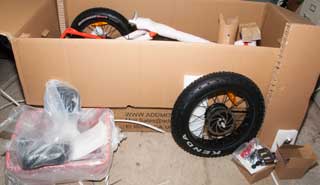
Fig 5 Want steering attached prior to pulling out of box to prevent straining cables. Neither tightness nor alignment important for this. Note fold down handlebar.
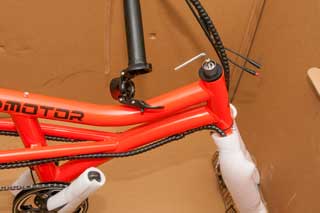
Fig 6 Removed battery and frame wrap prior to . . .
Tipping over box toward side with short lid and pulled out.
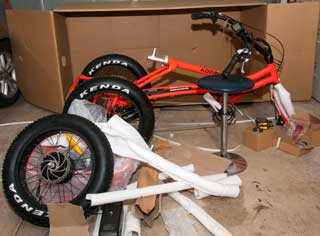
Fig 7 Problems with installing front wheel
Axle is 0.433 (11mm) across threads x 0.387 (9.8mm) across flats.
The washer-lug is 0.391 (9.9mm) wide, but is 90 deg out position so can not install front wheel.
No torque arm? (Luna Cycles: Torque-Arm)
While most of the frame is Aluminum, the front fork is steel.
Fig 8 Front Fork notches (vertical dropouts) are 0.403" (10.2mm).
Fig 9 Brake side of front wheel.
Here the lug lines up with the threaded part of the axle, so OK.
Front Wheel Fit & Front Torque Arm (initial assembly)
The front wheel does not fit (16 May 2019) and as part of investigating why I came across a number of articles about the need for torque arms with high powered hub motors.
eBike School: What is a Torque Arm and Why Do I Need One - "...750 watts or above should almost always use a torque arm, even in the rear of the bike, even in steel"
eBikes.CA - Torque arms - GRIN TorqArm_V3 -
Dr Bass Torque Arms – The Best Way Keep Your Dropouts From Breaking Without Using Ghetto Hose clamps - epoxy to frame, 100mm (3/8" thick to work with mild steel axle).
It turns out the problem was trying to keep the acorn nut, flat washer and lug-washer on the shaft while installing the wheel. By removing them on each side AND having a helper hold the bike frame it was straight forward to install the wheel and then fit the lug-washer with lug pointing down, flat washer and acorn nut.
The Lug-washer is there to spread the torque over more of the length of the threaded axle and so act like a torque arm.Overall Photos
Fig 20 Left Side
Battery removed for charging, Basket not installed yet
Fig 21 Right Side
Battery removed for charging, Basket not installed yet
Fig 22 Handlebar folded down
Note hinge is at odd angle so that when folded down
handlebar seats in low position.
Fig 23 Rear
Right rear is driven by pedaling, left wheel is free.
Both rear wheels have brakes.
Tail light (on here) is powered from main battery.
No AA cells needed.
Turn signals at rear.
By tipping the trike so the right rear wheel is in the air,
you can pedal to change gear settings without moving.
Fig 24 From motor up:
Flat washer, fork, Lug-Washer, flat washer, acorn nut.
Front fender, headlight (on here), electric horn.
Fig 28 Bafang FM G060.750.D 06
(see: Hub Motor above)
Fig 26 Left Handlebar: Front brake, electric controls
Fig 27 LCD
Hold "Menu" & "Plus(Up)" for a few seconds to turn on LCD back-light.
Fig 25 Right Handlebar: Rear brake, gear shift, throttle
Fig 30 Handlebar Adjustments
Fig 29 LCD (should be p/n: DWLCD-U see Fig 37)
marked: 9221013U08-1901-034424-0017 (48V)
Fig 31 Kenda 4.0 x 20 Tires
Fig 32 Rear top view
Fig 33 Max load 90 kg (198 Lbs)
Fig 34 Pedal Hall Effect cadence sensor & front of Battery
Fig 40 I have lowered the handlebar as far as possible.
This allows "Digging In", i.e. pulling up on handlebars
and pushing down on pedals for more pedal power.
(read that grips on "pedal forward or flat foot" bike design should be 1" to 2" above knees.)
Fig 41 Left side view.
Fig 44 Rear axle assembly bolts on main frame.
Fig 46 Installed Aluminum tubing basket
I was hoping the water bottle holder was in the basket.
That is what the two small screws sticking up on the top horizontal tube are for. But it seems to be missing.
Fig 47 Rear View Mirror
eBay: "Aluminum Bike Rear View Mirror Mountain Bicycle Rearview Handlebar End Back US" <$10
Fig 48 Basket has large holes.

Fig 49 Water Bottle Mount (no mount came with M-360)
Fig 50 Three P-Clamps installed on both front forks.
Tin cans of rocks removed.
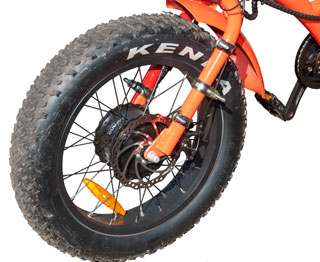
Fig 51 two tin cans of rocks weighs 17 pounds total.
New weights to be 20 pounds total, 10# on each side.
Fig 52 Right side P-clamps for weights
Fig 53 Left side P-clamps for weights
Fig 54 2020 May 31: received 4 deburred & painted steel plate weights.
Fig 55 With a pair of the weight plates installed the front tire still spins going up my driveway.
Fig 56 Each pair of weight plates weighs 20 pounds. Need to install two pair (40 pounds) of weights to get traction.
Patents
Trailer
Saw this YouTube:114$ Bike Trailer from Amazon (E-trike v1.7) - which lead to the Aosom web page and their Folding Bike Cargo Trailer Cart with Seat Post Hitch -
The other trailers are intended to be towed behind a bicycle and the two bar is designed that way. The seat post hitch should work on a trike as well as a bike.
The wheels are supported on both ends of the axle for each wheel so adding hub motors may be a possibility.
This is another way to get more hill climbing capability.
Related Trikes
AddMotoR
M-330
A series of Fat tire (Wiki) tricycles by AddMotoR includes the M-330 (YouTube Nov 27, 2018, Glider Launch Aug 2018)). and the newest version that is going to be offered for sale in about a week, the M-360. The M-330 and M-350 look very much like the existing adult tricycles with an added motor. The M-360 is a new lower design that's considerably more modern.
Intro YouTube: Addmotor MOTAN M-360 Electric Trike Beach Cruiser - note the seat post is horizontal, unlike the vertical arrangement on the M-330 and M-350.M-350
and later the M-350 (YouTube: M-350 Dec 13, 2017, M-350 May 2018,
YouTube: EBR:AddMotoR MOTAN M-350 Video Review - $2.6k Electric Fat Trike with Throttle and Lig hts May 12, 2018- 35:24- (5:17) 500W, 80nm Bafang: he does not get the huge difference between geared and direct drive hub motors, (7:21) he does not realize that there's no differential and so only one rear wheel is powered by pedaling and also only one rear wheel is slowed by the rear brake. (13:40) Mozo 80mm travel, front suspension on M-350, none on M-360. The M-350 has 30mm seat post suspension travel, the M-360 has none. (16:33) Silver Fish (Dorado?) type battery. 30" width so close to interior door size of 30". AddMotoR MOTAN M-350 Review -
EBR:
YouTube: AddMotoR: How to assemble the handlebar/wheels of Addmotor M350 electric trike? Feb 8, 2018, 15:59 -
Box contents
2:55 - Handlebar (different from M-360, which has the fold down handlebar)
4:59 - Mount rear wheels, Right wheel, square drive hole, left non-drive round hole. (already mounted on M-360 which has threaded end of axle with nut, different from the screw used on M-350.
8:15 - Install front fender & Lamp Holder + Lamp (M-360 also has electric horn)
10:24 - Install Front Wheel (takes 2 people)
13:26 - Connect cable for LCD
13:53 - Install Seat
14:38 - Install pedals correctly right and left -
Other Brands
I've seen adult trikes, like the Sun Atlas, where the owners have been happy with the ability to carry more cargo than on a bicycle. The early electric trikes were based on adding a motor to this style trike.
A possible precursor to the M-330 may be the JSE-Moto - Fat Tires Electric Tricycle 500W Cargo Bike - YouTube:Fat Trik e Nov 19, 2018, or a rebranded M-330?
The iZip E3 Go eTrike and Raleigh Tristar iE e-Trike seem to be the same 350W mid drive trike.
YouTube:
YouTube: Trivel: Azteca Presentation, Oct 15, 2017 3:1 - Azteca Electrique Nov 26, 2017, 2:41 - (Also a demonstration of a small quad copter with camera).Trivel E-Fat Azteca Video Review - $3.9k Electric Recumbent Fat Trike - May 17, 2018 has a strong resemblance to the M-360. - Trivel - Azeca Fat Electric - Trivel E-Azteca Video Review - $3.7k Electric Delta Trike, Recumbent, Adjustable, Twist Throttle, Oct 3, 2018, 21:27- skinny tires, not the fat but otherwise the same -
YouTube: EBR2018 Velec Electric Bikes and Trivel Fat Electric Recumbent Trike | Electric Bike Report, Sep 28, 2017, 4:57 - (3:15) Trivel Fat Trike made in cooperation with Velec eBike. (all with 2 wheels)
EBR: Trivel E-Azteca Review -
Transportation
Hitch Rider - 1 Trike Rack Videos - YouTube Channel - limited to 3" max wheel/tire size i.e. NOT 4" tires.
Related
3 Wheel Recumbent Electric Bikes
Bicycle Science
Cars
DC Permanent Magnet Motors - Testing
Motorized Bikes & Motor Scooters -
Tilting Three Wheeler Patents -
References
Wiki: List of motorized trikes - many vehicles I like.
ELF eTrike with 2 front steering wheels in front 1 drive wheel in back.
Links
PRC68, Alphanumeric Index of Web pages, Contact, Products for Sale
Page Created 2019 May 9 - Order date
